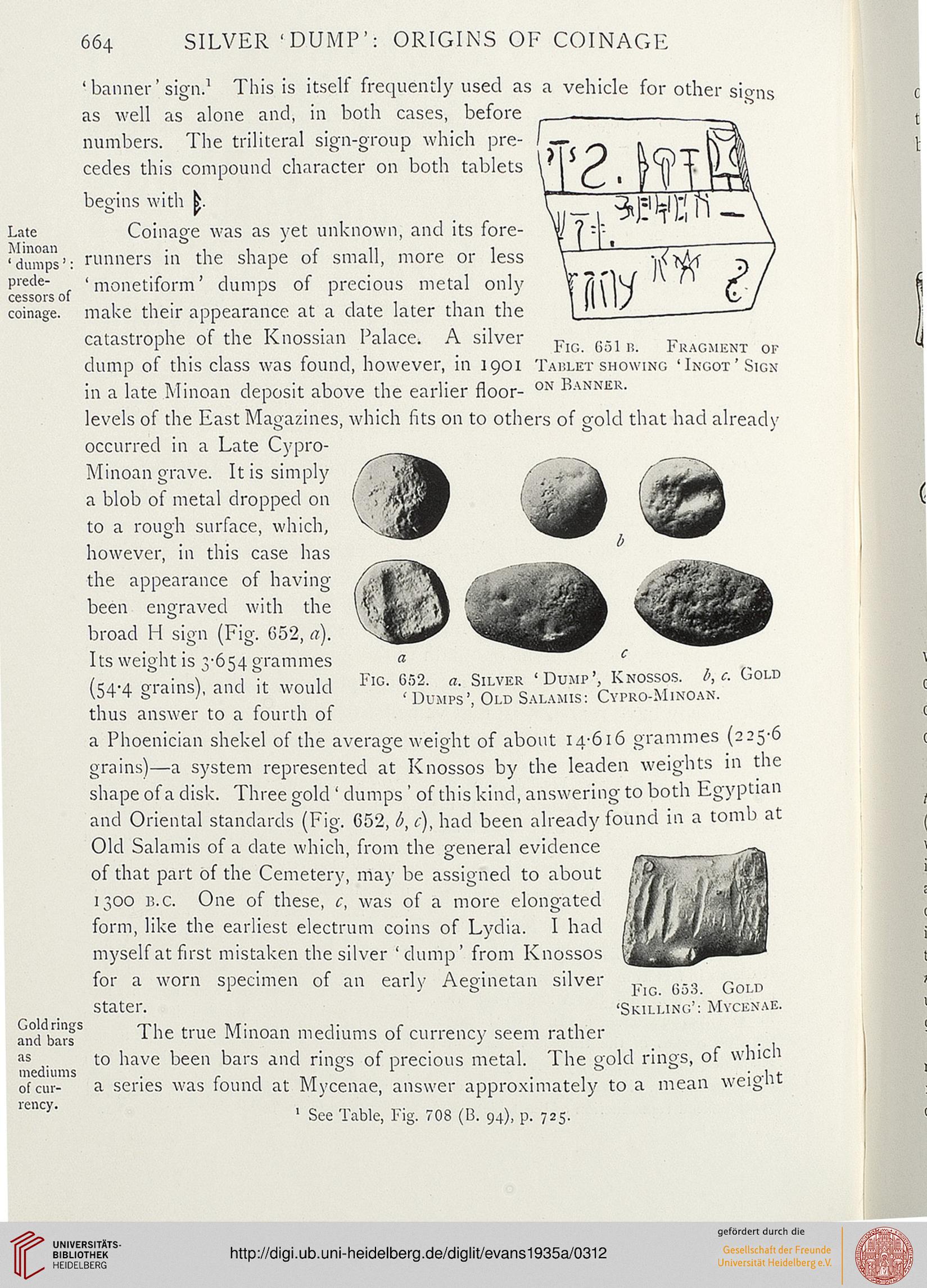664
SILVER 'DUMP': ORIGINS OF COINAGE
banner'sign.1 This is itself frequently used as a vehicle for other signs
as well as alone and, in both cases, before
W]{lJj
numbers. The triliteral sign-group which pre- j
cedes this compound character on both tablets
begins with £.
Coinage was as yet unknown, and its fore-
runners in the shape of small, more or less
'monetiform' dumps of precious metal only
make their appearance at a date later than the
catastrophe of the Knossian Palace. A silver F|[. 65] B Feagmeht op
dump of this class was found, however, in 1901 Tablet showing 'Ingot'Sign
in a late Minoan deposit above the earlier floor- 0N r>ANNER-
levels of the East Magazines, which fits on to others of gold that had already
occurred in a Late Cypro-
Minoan grave. It is simply
a blob of metal dropped on
to a rough surface, which,
however, in this case has
the appearance of having
been engraved with the
broad H sign (Fig. 052, a).
Its weight is 3-654 grammes
(54-4 grains), and it would
thus answer to a fourth of
a Phoenician shekel of the average weight of about 14-616 grammes (235-6
grains)—a system represented at Knossos by the leaden weights in the
shape of a disk. Three gold ' dumps ' of this kind, answering to both Egyptian
and Oriental standards (Fig. 652, 6, c), had been already found in a tomb at
Old Salamis of a date which, from the general evidence
of that part of the Cemetery, may be assigned to about
1300 B.C. One of these, c, was of a more elongated
form, like the earliest electrum coins of Lydia. I had
myself at first mistaken the silver 'dump' from Knossos
for a worn specimen of an early Aeginetan silver
stater.
The true Minoan mediums of currency seem rather
to have been bars and rings of precious metal. The gold rings, of which
a series was found at Mycenae, answer approximately to a mean weig
' See Table, Fig. 708 (13. 94), p. 725.
Fig.
652. a. Silver 'Dump', Knossos. /', c. Gold
'Dumps', Old Salamis: Cypro-Minoan.
Fig. 653. Gold
'Skilling': Mycenae.
ht
SILVER 'DUMP': ORIGINS OF COINAGE
banner'sign.1 This is itself frequently used as a vehicle for other signs
as well as alone and, in both cases, before
W]{lJj
numbers. The triliteral sign-group which pre- j
cedes this compound character on both tablets
begins with £.
Coinage was as yet unknown, and its fore-
runners in the shape of small, more or less
'monetiform' dumps of precious metal only
make their appearance at a date later than the
catastrophe of the Knossian Palace. A silver F|[. 65] B Feagmeht op
dump of this class was found, however, in 1901 Tablet showing 'Ingot'Sign
in a late Minoan deposit above the earlier floor- 0N r>ANNER-
levels of the East Magazines, which fits on to others of gold that had already
occurred in a Late Cypro-
Minoan grave. It is simply
a blob of metal dropped on
to a rough surface, which,
however, in this case has
the appearance of having
been engraved with the
broad H sign (Fig. 052, a).
Its weight is 3-654 grammes
(54-4 grains), and it would
thus answer to a fourth of
a Phoenician shekel of the average weight of about 14-616 grammes (235-6
grains)—a system represented at Knossos by the leaden weights in the
shape of a disk. Three gold ' dumps ' of this kind, answering to both Egyptian
and Oriental standards (Fig. 652, 6, c), had been already found in a tomb at
Old Salamis of a date which, from the general evidence
of that part of the Cemetery, may be assigned to about
1300 B.C. One of these, c, was of a more elongated
form, like the earliest electrum coins of Lydia. I had
myself at first mistaken the silver 'dump' from Knossos
for a worn specimen of an early Aeginetan silver
stater.
The true Minoan mediums of currency seem rather
to have been bars and rings of precious metal. The gold rings, of which
a series was found at Mycenae, answer approximately to a mean weig
' See Table, Fig. 708 (13. 94), p. 725.
Fig.
652. a. Silver 'Dump', Knossos. /', c. Gold
'Dumps', Old Salamis: Cypro-Minoan.
Fig. 653. Gold
'Skilling': Mycenae.
ht




